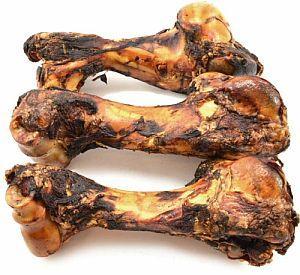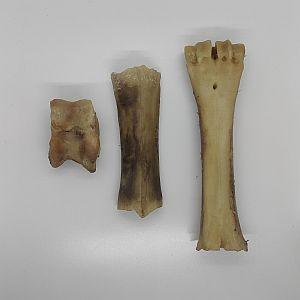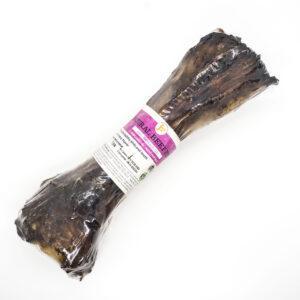
Roasted Beef Bones
We see them in many pet shops. Roasted Beef Bones of all sizes. But are they good for our dogs?
We don’t think so! Let’s face it, a dog’s natural diet is raw, so why would we want to cook them in the first place?
Because dogs have become domesticated, they have become part of the family. How many of us are tempted to give them food off our own plate? Some dogs main diet is our food scraps and left overs. And, as dogs eat bones, there is also the temptation to give them the bone as a treat after we’ve carved the meat off it.
The trouble is, once a bone has been cooked, it is far more likely to break, crack and/or splinter. This is when it can get caught in the throat, or even further inside the dog, not only causing discomfort or pain, but even result in an expensive vet bill to remove the offending piece(s) of bone and repair the damage, or worse ☹
Raw vs Cooked
and food-borne diseases. Yes, there are risks with raw, but these are minimal. Remember, dogs in the wild would be eating a raw diet!
Raw food is an excellent source of the vitamins and minerals our dogs need. The cooking process starts to destroy these, making the nutritional value less effective. But, if you are concerned that the Beef Bones (or any other bones, for that matter) you give your pooch could cause issues either cooked or raw, then what’s the answer?
Air Dried Bones
Well, there is an alternative.
Air Dried. Pasteurised, if you like. It’s the best of both worlds. They are not cooked, so they do not suffer the splintering or cracking problems. Neither do they suffer the associated deterioration in vitamins and minerals.
But, they are not raw either. So they retain the vitamin and mineral content without the risk of bad bacteria causing food-borne diseases.
Another advantage in being Air Dried means that they don’t go off! Looked after, there can be many hours of chewing delight for your dog in a Beef Bone.
Our boys thoroughly enjoy a good chew on these, particularly after their main meal. For them, it seems they are “doggie dessert”!
Roasted Bones
Our personal experience of roasted beef bones is that they are messy, smelly and greasy. Not only unpleasant to handle, they can leave greasy marks on your furniture and carpets. Yuck! They can also cause stomach upsets and diarrhoea. Yuck again! And, with the very real and ever-present danger of splinters causing injury to your best friend, we believe you should steer well clear.
Anal Glands
OK. Not the nicest of subjects. But if your vet frequently has to clear out your dog’s anal glands, then an air-dried bone could be the best – and most natural – answer.
Looking after your Beef Bones

We stock the JR Beef Bones. This is the foot, otherwise known as the Beef Shank. They come with a little bit of meat on them – something really tasty to get your pooch going. When we are selling canal-side, a good many canine noses start heading towards the bone display!
When you’ve bought your Beef Bones, the first thing to remember is don’t put them in the fridge. There’s no need. Simply unwrap when ready and give to your dog, who will doubtless be delighted!
Please note that the amount of meat content will vary as these are natural products. This will probably result in slightly loose poos after the very initial session or two with one of these bones, but this is normal. It is often better to restrict gnawing time at this stage.
Once they have got all the meat off and are down to the bone, then they will really start chewing. This action is a natural teeth cleaner! The chances are that they will get the knuckles off in either one or two separate pieces. These are also great to chew on. At this stage, you should find that their poos firm up and this is what really helps the anal glands in the way that nature intended.
The photograph shows some Air Dried Beef Bones after some rigorous chewing! On the left is the knuckle bone, which has been chewed off. Centre and right are the shanks at various stages. As you can see, they are very clean, with no signs of splintering. The knuckle and smaller shank have been on the go for about 4 months. They are chewed daily by our two, demonstrating how long-lasting they can be.
Safety First
The key thing is NEVER to give your dog cooked or roasted beef bones. Or, indeed, ANY bone that’s been cooked in any way, even if it is sold as a dog chew.
Raw bones, fresh from a trusted butcher, are fine, but should be given to your pet immediately. It should be kept in the fridge when not being chewed and disposed of after a couple of days.
Air Dried Bones, such as the JR Beef Bones or JR Ostrich Bones, are perfect. They can be kept on the go for several months, but do not be tempted to fill or coat them with anything as this will make them go off! Your dog will enjoy a good gnaw on these – often as a stress reliever or a relaxation after a meal. They are great for cleaning teeth and, as we’ve mentioned above, they help bulk up their poo, thus reducing the risk of anal gland problems.
Do not store air dried bones in the fridge – simply keep in your dog’s toy box or other safe, dry storage location.
Always supervise your dog when you give them any type of chew and inspect it both before and after to make sure that there are no bits which may pose a risk. Once the bone gets small enough to be swallowed whole, it could pose a risk of choking, so then is the time to replace it with a new one!
You may wish to restrict the length of time your dog is allowed with a bone in any one sitting if they are a real power chewer.
If your dog has any food sensitivities, then always check with your vet before giving them any new foods, chews or bones.
Alternatives
You may wish to consider Chicken Feet as a healthy alternative to a big bone. Perfect as a high-value reward and great for dogs who are not so interested in bigger bones. Air Dried not cooked, they are perfectly safe. Good for helping to clean teeth, and they are also a great source of glucosamine – perfect for keeping your dog’s joints healthy.
We also stock a variety of alternative bone-based chews, including Ostrich Metatarsus Bones, Ostrich Toes, etc. Take a browse through our Chews and Bones shopping aisle for more ideas!
The bottom line is: avoid roasted beef bones.



